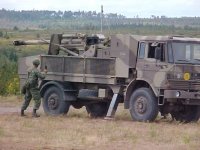CBH99 said:
...
But after reading that article, especially about the supply chains & support vehicles all being able to be lighter, less maintenance intensive, more ammo being able to be moved, and that a larger number of rounds will probably be more effective than the size of the rounds - it helped me change my perspective on the light artillery gap.
Maybe there actually is quite a useful role for light artillery after all, and have some available for operations in addition to the M777 would actually help fulfill more capabilities that I hadn't thought of. ...
I definitely think that there is. But in part that requires that we structure our brigades better. While we could structure our artillery regiments with two M777 batteries for the two LAVs and a light battery for the light infantry battalion, it would make more sense to reorganize the brigades into a light and two medium LAV brigades and assign guns accordingly. (I'm also still a holdout for a heavy brigade with tanks, IFVs and SPs)
In the days that we had L5s, (2,840 lbs) we could lift them with our Hueys and tow them with 3/4 ton trucks (although we also used 2 1/2 ton and M548 portees) while the C1s (4,980 lbs) needed Voyageurs and deuce and a halfs. Now you need a Chinook to lift an "ultralight howitzer" M777 (9,300 lbs). The US M102 and the GIAT LG1 are only slightly heavier than the L5 at 3,300 lbs while the Brit L119 comes in at 4,100 lbs. The UH-1N could lift 5,000 lbs externally. I'm not sure if the Griffon has that capability but my guess is that it probably doesn't but might still be able to lift a stripped down L5.
If one could move to a UH-60 Blackhawk with 9,000 lb external lift one would have much more flexibility in what kind of gun to employ.
Those weight factors and how easily you move the gun (and it's ammo) plays almost (but not quite) as big a role as the gun's range because it affects how easily you can move the thing and employ it in difficult terrain where your supported grunts might have to operate. I was with the Italians in the Alps and saw just how useful a little piece of kit like the L5 could be for a light footborne force. Even the C1 would have had difficulties there.
That difficult terrain issue also plays into truck mounted self propelled guns. Sometimes you just can't get a vehicle borne/towed gun into where it's needed and that's where you are left with a light gun/mortar choice. I think the Airborne Battery in its day had the right concept being able to field either 6 x L5 packs or 12 x 81mm mortars or a combination of the two depending on the operation.
My problem in this entire debate is that we should never, ever have "training" guns. What we need are the guns that we intend our soldiers to go to war with. By all means get them to use subcalibre training devices to save training ammunition costs but if you don't have the "war gun" when its needed then you won't be able to go to war. Right now we don't have enough M777s and we don't intend to fight with anything else. Just as important, one (and that's everyone from the gunner to the regimental commander) doesn't develop the ongoing muscle memory of training on the gun you will fight with - learning it's capabilities, limitations and idiosyncrasies. You'll forever be having to do predeployment conversion training which is not the same as having trained for years on the kit you are going to fight with.
I think the many years of making do with the substandard equipment that we have and the substandard organizational structures that we have had to serve in has gotten us to exactly the state we are in now.
:stirpot:


